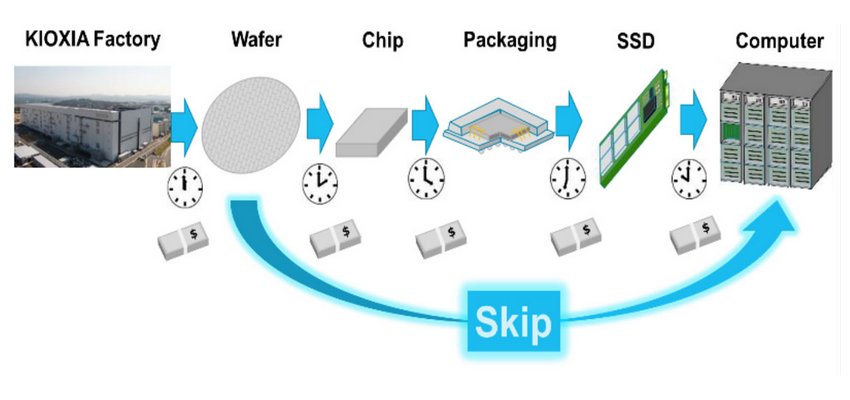Kioxia floats concept of ‘wafer-level SSDs‘
Kioxia, formerly Toshiba Memory, has talked about plans for a new way of delivering flash storage it calls “wafer-level SSD”. The concept is to skip all the dicing, assembly, packaging, and SSD drive assembly seen in conventional flash memory and SSD manufacturing methods and simply mount the entire wafer to deliver a huge chunk of data storage with high performance.

Using what Kioxia calls “super multi-probing technology”, hundreds of chips in a single wafer can be probed – presumably meaning wired up – and operated in parallel, which could enable enormous performance and millions of IOPS. The plans were discussed by Kioxia Chief Engineer Shigeo Oshima in a presentation at VLSI Symposium 2020.
Kaminario becomes Silk
All-flash array pioneer Kaminario has changed its company name to Silk. In a statement on its new site, the firm explained that the cloud had changed the way most organisations use storage, and so it was changing its mission to help businesses get more out of their cloud data while keeping a lid on spending.
“We searched for a name that tells the story of how we help businesses become stronger yet more flexible….so we chose the one unique element in nature that is all those things. Silk,” the statement says.
As Kaminario, the firm adapted its VisionOS storage software to operate on AWS, Azure and the Google Cloud Platform earlier this year.
Silk says that its Cloud Data Platform “fits between your full application stack and cloud data infrastructure, making everything run smarter. Without changing your environment.” It claims to reduce cloud costs by 30 percent by optimising cloud data use through techniques such as real-time data reduction and thin provisioning.
A pair of shorts
Unstructured data management firm Data Dynamics has concluded a $9m financing round to help to scale its sales and marketing teams, and expand its product portfolio. The company says its tools are deployed in over 25 per cent of the Fortune 100, delivering hundreds of millions of dollars in cost savings and risk mitigation.
Integrator Diaway has unveiled an edge server aimed at high performance workloads. The Edgebox combines AMD EPYC 7002 Series processors, Western Digital storage (Ultrastar DC HC500 Series and NVMe SN640 drives) with enterprise-grade networking and network management from Juniper Networks. Edgebox is a single-socket 2U server designed to handle workloads like software-defined storage, virtualization, hyper-converged infrastructure, and data analytics.
People
The Storage Networking Industry Association (SNIA) has appointed Dr. J Michel Metz to serve as Interim Chair of the SNIA Board of Directors. Metz succeeds David Dale, who stepped down from the role as SNIA Board Chair after serving in that position for seven years. This appointment is effective until SNIA’s Annual Members’ Meeting in October 2020, when annual officer elections will be held.

Bobby Soni is to succeed Brian Householder as President of Hitachi Vantara’s Digital Infrastructure Business Unit (DIBU), effective August 3, 2020. Householder is leaving Hitachi after 17 years with the company. Soni has served for the past year as chief operating officer and was previously the company’s chief solutions and services officer, and senior vice president of cloud, global services and emerging solutions.
UK digital archiving specialist Arkivum has appointed Chris Sigley as its chief executive. Sigley joined the UK-headquartered company in June, will lead Arkivum as it aims to acheive further growth in its specialist market. He was previously at data management specialist Redstor for 15 years, most recently as chief sales officer.







